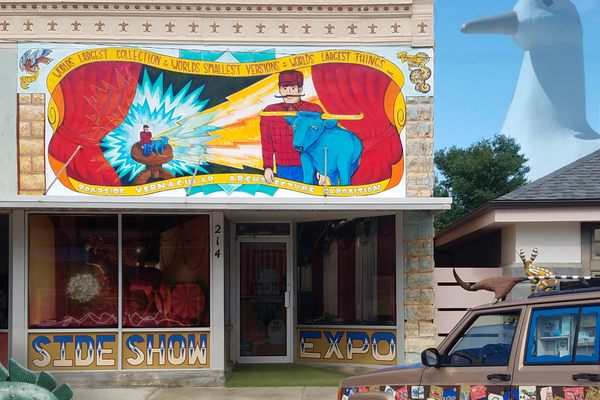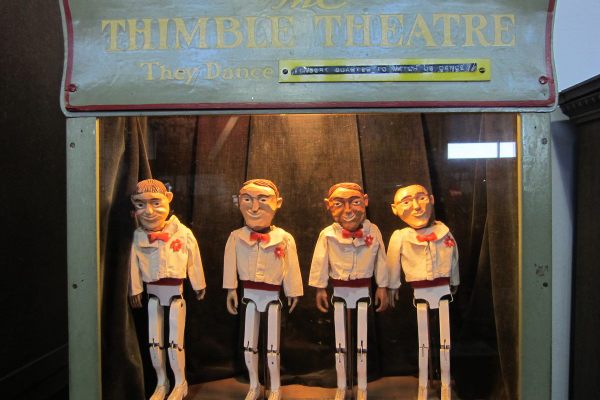Twilight of the American Roadside: A Museum of Lost Americana Survives off the Map
 The Miracle of America Museum in Montana (all photographs by Eliza Berman & Dan Logan)
The Miracle of America Museum in Montana (all photographs by Eliza Berman & Dan Logan)
It would be easy to drive right past the Miracle of America Museum were it not for the rusty orange VW Bug perched on its flat roof. Two billboards on the west side of U.S. Highway 93 implore drivers to make a pit stop in Polson on their way toward northern Montana. But with no explanation for what, exactly, the Miracle of America is, it’s hard to know whether it will be worth the detour.
If you do pull off the highway and walk by the sign announcing “This Is Not a Tourist Trap,” past the piece of paper listing the five dollar cost of admission and a slice of half-eaten lemon meringue pie languishing on the counter, you’ll find the Miracle of America in one of the largest collections of American memorabilia owned by a private individual.
Nestled in the northeast quadrant of Montana’s Flathead Reservation, just west of the Flathead National Forest, the museum boasts more than 150,000 relics of American history, from fishing tackle to taxidermy. But a limited advertising budget has kept it off most tourists’ radar. A good day might see 50 visitors, and a bad day, at the height of winter, might see none.

 Gil Mangels, who founded the museum in 1981 with his late wife Joanne, wears large round glasses and a name tag. After taking my five dollars, he remarked on the clicking fax machine in the corner of the room. He admits he doesn’t really know how to use it. “Why don’t they make things like they used to make radios?” he asked rhetorically. “Turn it on and off, volume up and down, and that’s it?” The question makes him sound like a Luddite, but that’s not the case at all. In fact, to Mangels, one of the miracles of America is innovation. That, and freedom.
Gil Mangels, who founded the museum in 1981 with his late wife Joanne, wears large round glasses and a name tag. After taking my five dollars, he remarked on the clicking fax machine in the corner of the room. He admits he doesn’t really know how to use it. “Why don’t they make things like they used to make radios?” he asked rhetorically. “Turn it on and off, volume up and down, and that’s it?” The question makes him sound like a Luddite, but that’s not the case at all. In fact, to Mangels, one of the miracles of America is innovation. That, and freedom.
Mangels is a collector, and has been since he was a boy of about four and found a sharp rock on the ground. He showed it to his mother, who told him it was an Indian arrowhead. “You need to save that,” she told him. “And I’ve been saving ever since,” he says, as though he’s told the story more than a few times.
After a stint in the military, Mangels began to see a greater meaning in the objects he collected. “I had the occasion to go behind the Iron Curtain when the wall was still up,” he recalls of his time in Germany. “And I didn’t like the feeling in a Soviet-controlled country. I’d taken my freedom for granted prior to that.” When he and his wife opened the museum years later, this patriotic spirit wove its way through the exhibits.
More than just an appreciation for freedom, Mangels hopes the museum will inspire intergenerational connections. “Artifacts spark memories,” he says, explaining that he’s seen four generations of a family come in, the objects providing concrete starting points for children to learn about their grandparents’ lives. “What’s really neat is to see a Vietnam veteran with their child or their grandchildren,” he says. “Whereas before they didn’t have that opportunity to bring the subject up, a lot of them will open up with stories and their feelings.”
Mangels might ask if there’s anything that’s of particular interest to you before you make your way through the museum, but the best way to experience it is to take an afternoon and meander, turning right at every intersection. The place has a homemade feel, like a giant collage. Handwritten signs hang next to dioramas that might be more at home at a science fair. The Louvre, this is not.


But a collector’s dream, it is. There are toys, from hundred-year-old dolls, to Lone Ranger figurines, to comic books. There is campaign memorabilia from Hoover to Clinton, WWII propaganda, and army fatigues. Tricycles and bicycles, hearses and tractors, vacuum cleaners and iceboxes and sewing machines. A self-playing Remington offers up ragtime tunes for a quarter.
That the museum is hardly on the map is a travesty and a blessing, depending on your vantage point. It’s a travesty if you’re Mangels, constantly seeking funding to keep your doors open. And it’s a blessing if you’re the kind of traveler who relishes diamonds in the rough and appreciates the lack of queue and crowd. Hopefully, for the sake of Mangels and his grandson, who has agreed to keep the museum going in future decades, the trickle of visitors will increase to a steady stream, and the artifacts will continue conjuring memories.
Because Mangels isn’t in it for the money. When asked if he has any idea of the value of his collection, he shakes his head. He doesn’t know, and he never plans to find out. “When the good lord takes me,” he says, “he can have it.”

















All photographs by Eliza Berman and Dan Logan.







































Follow us on Twitter to get the latest on the world's hidden wonders.
Like us on Facebook to get the latest on the world's hidden wonders.
Follow us on Twitter Like us on Facebook